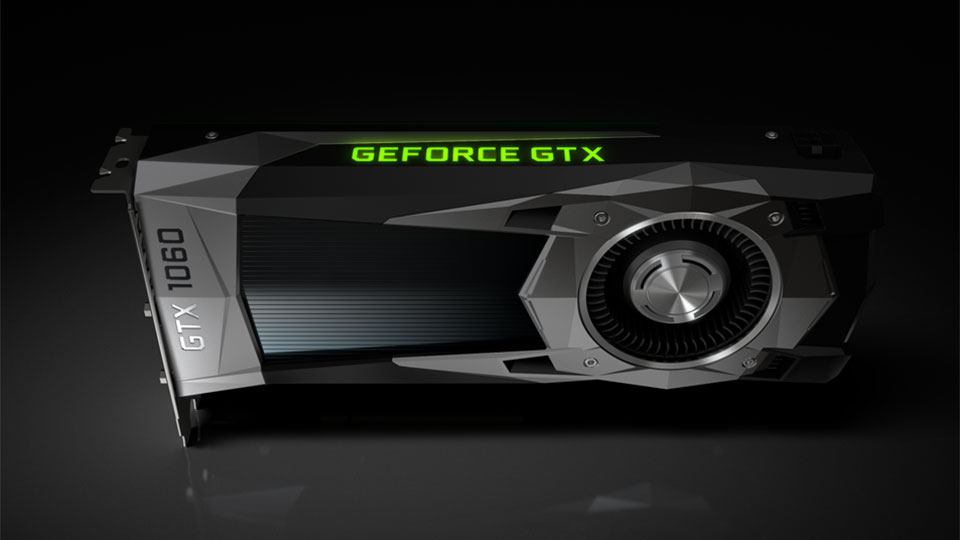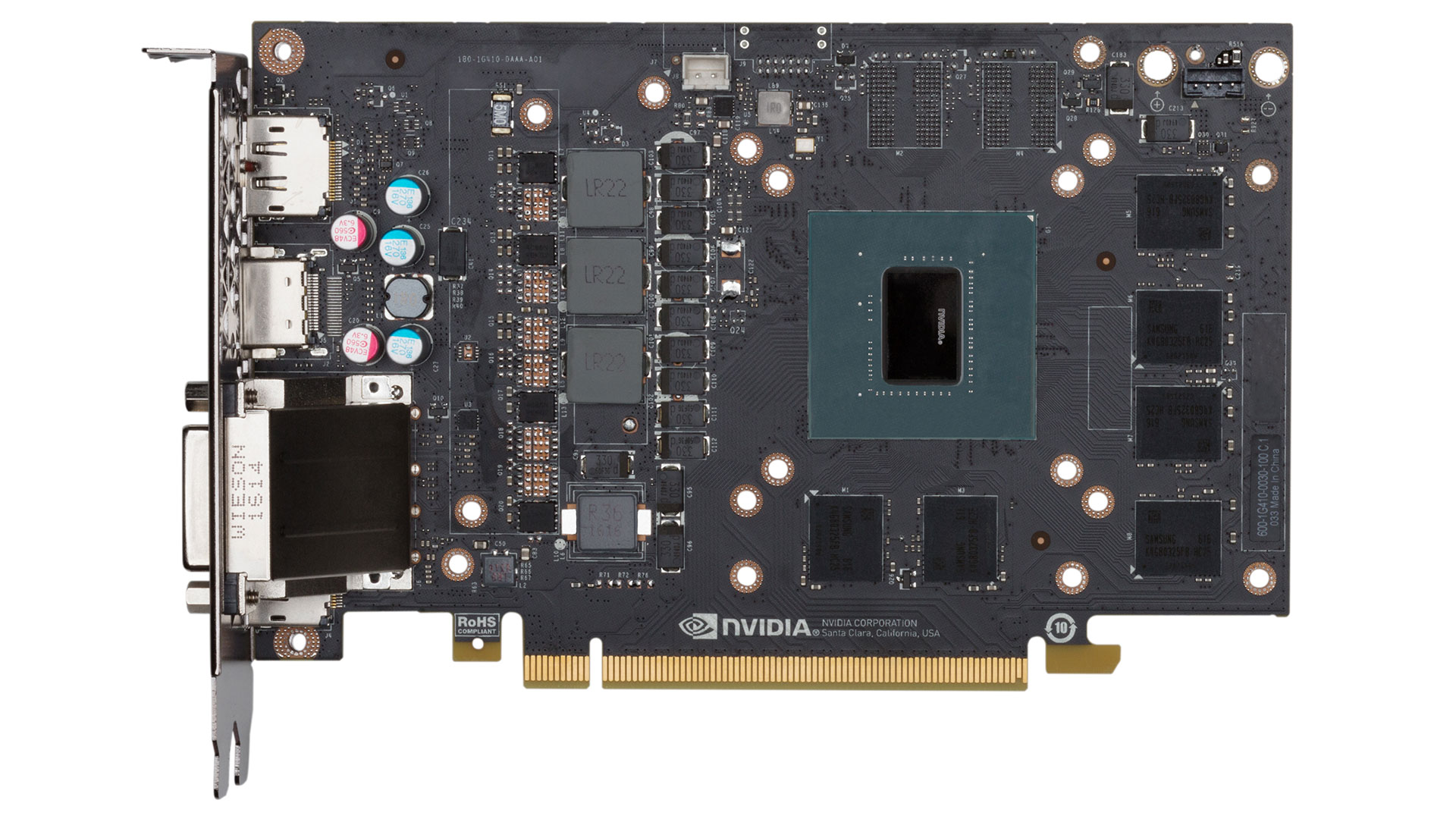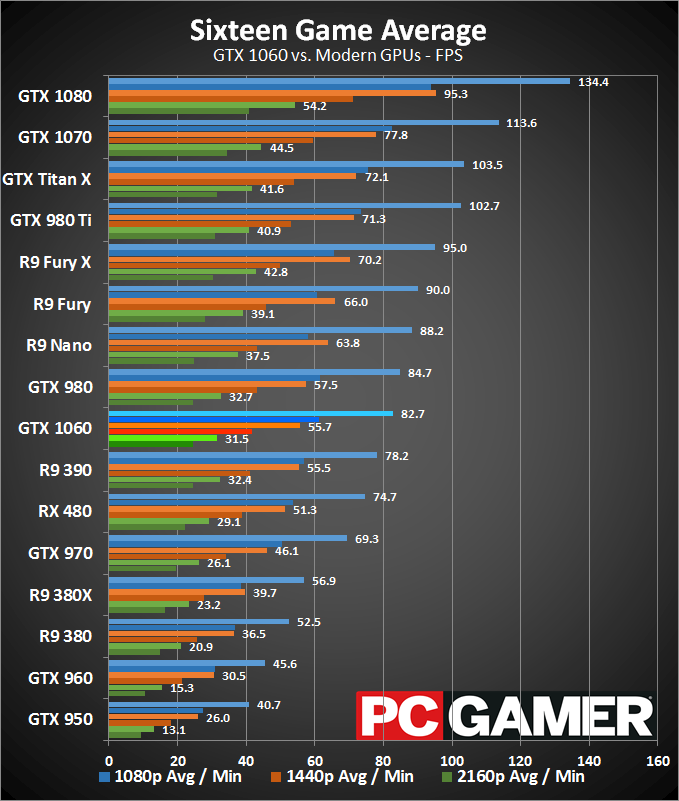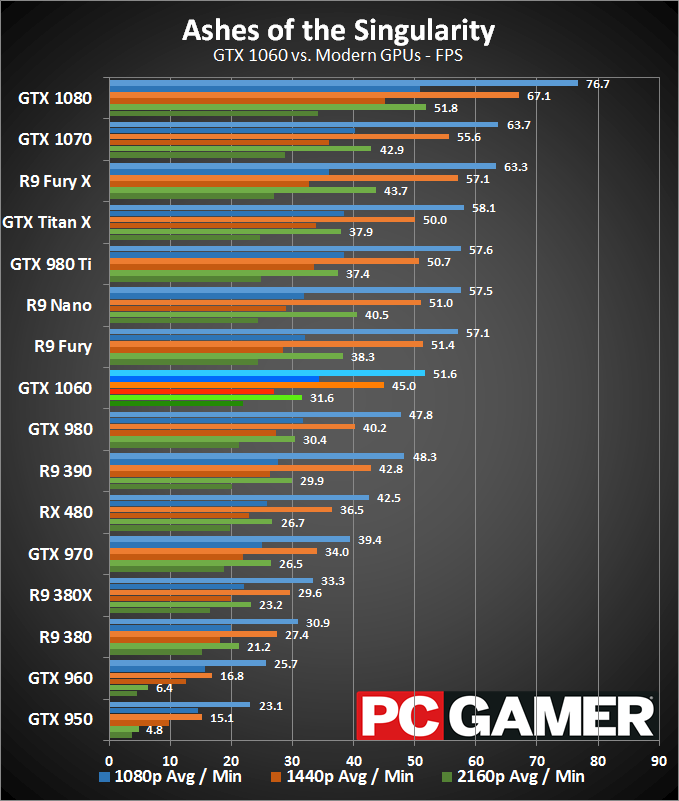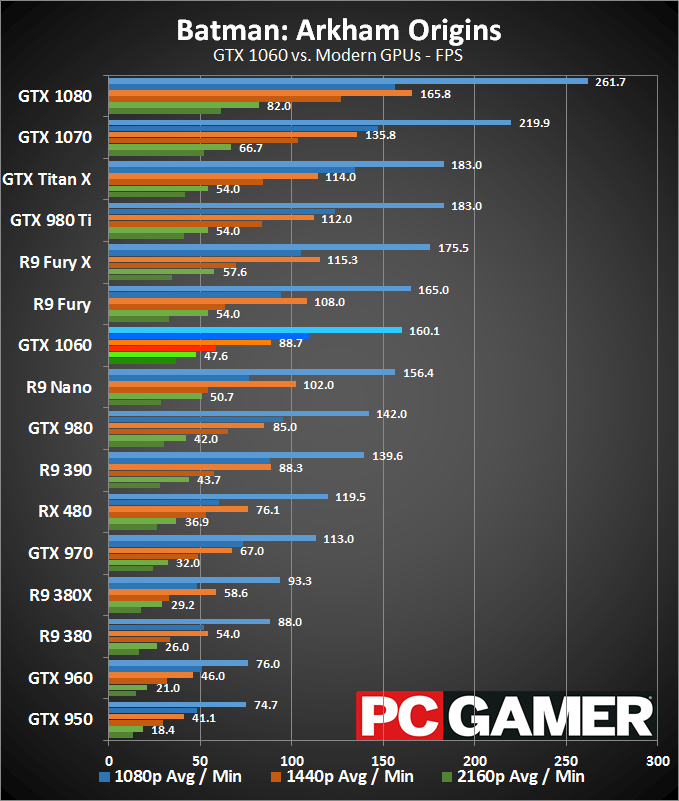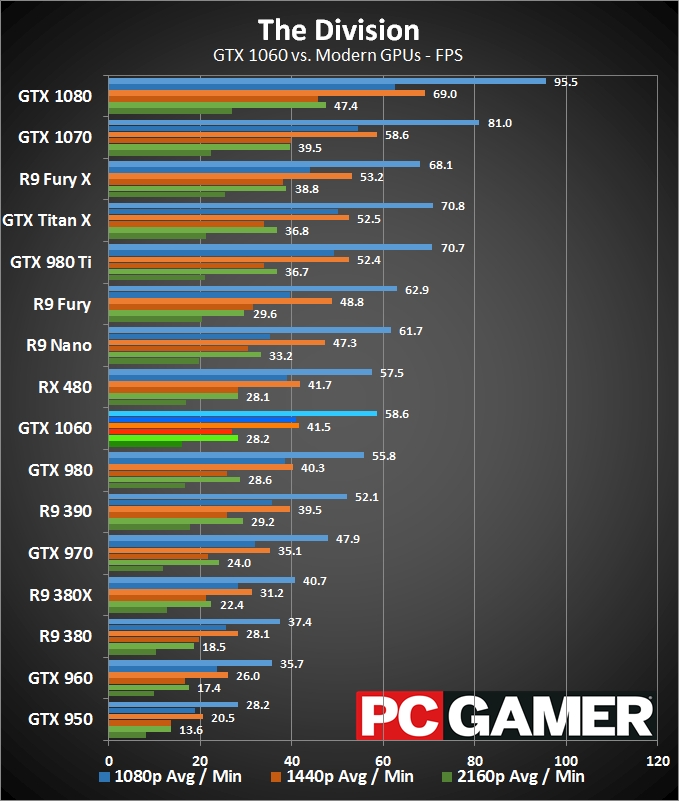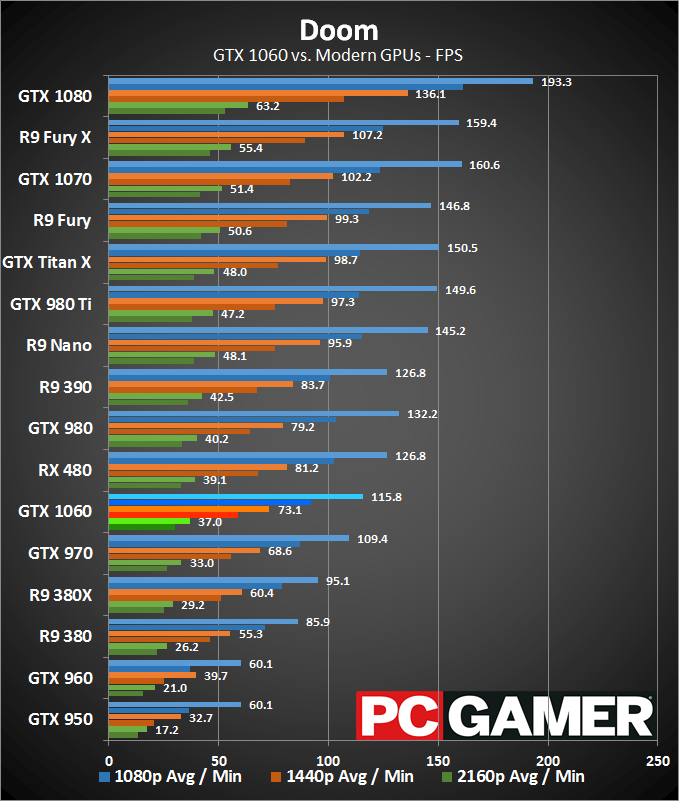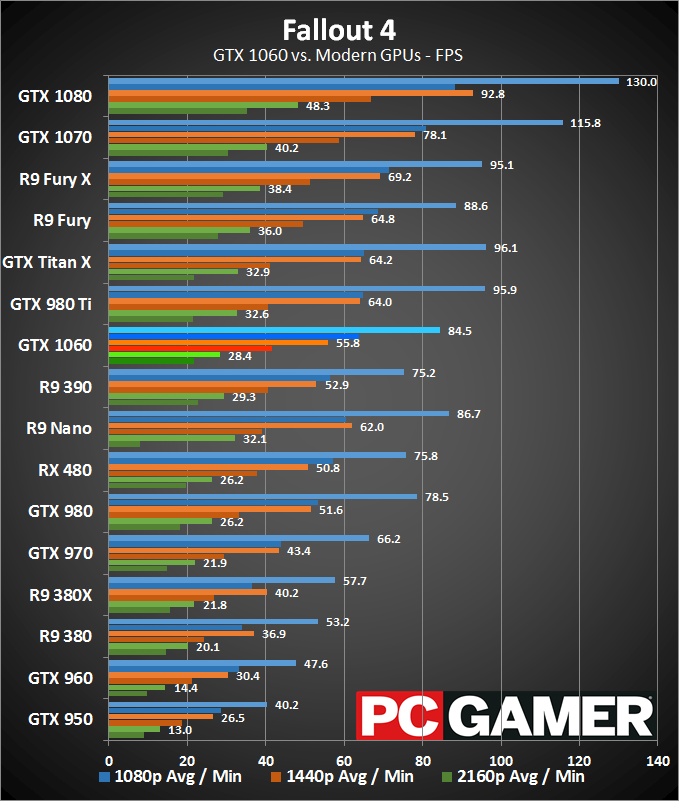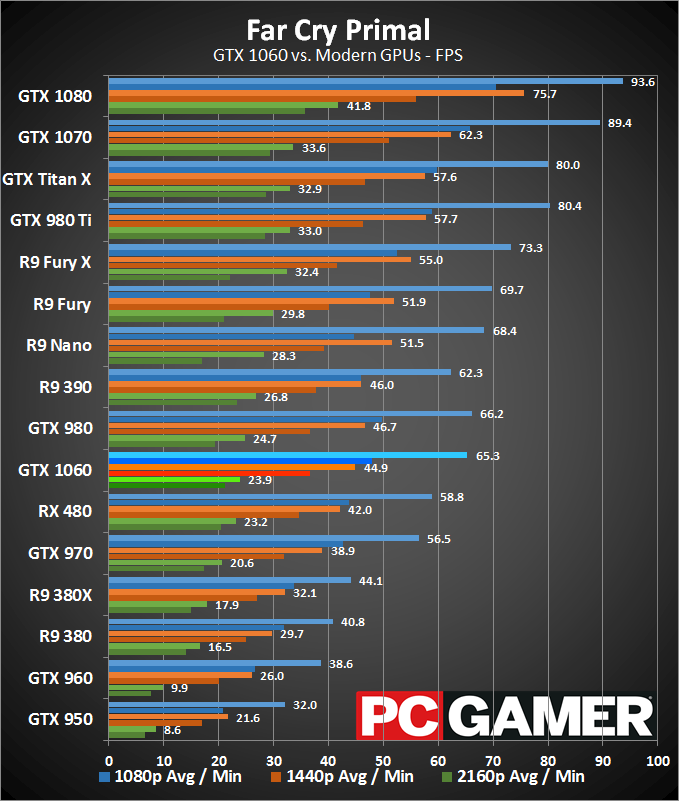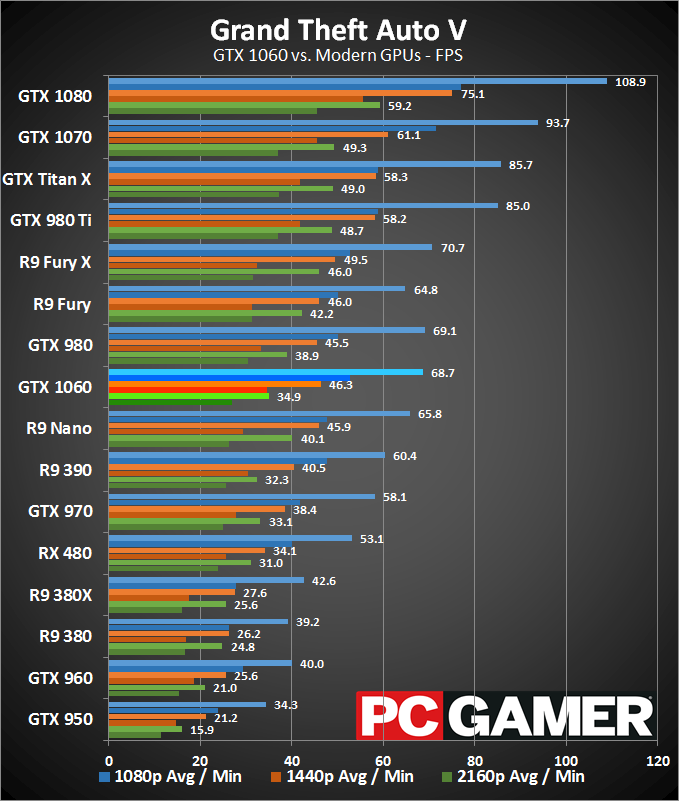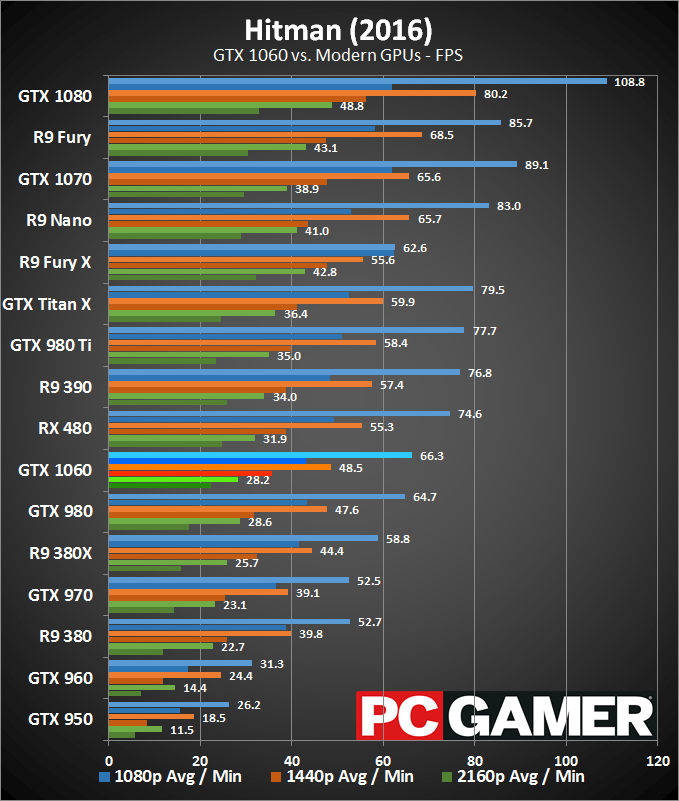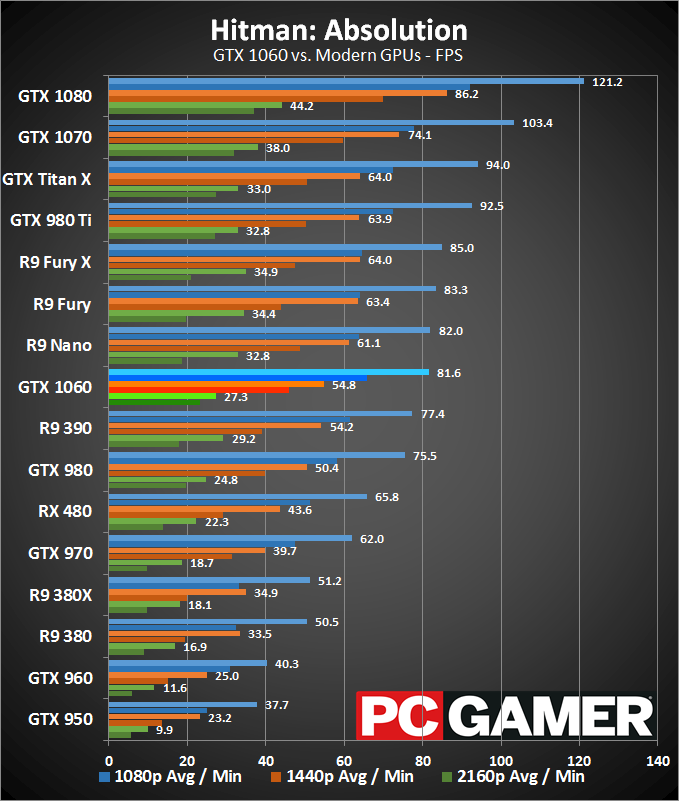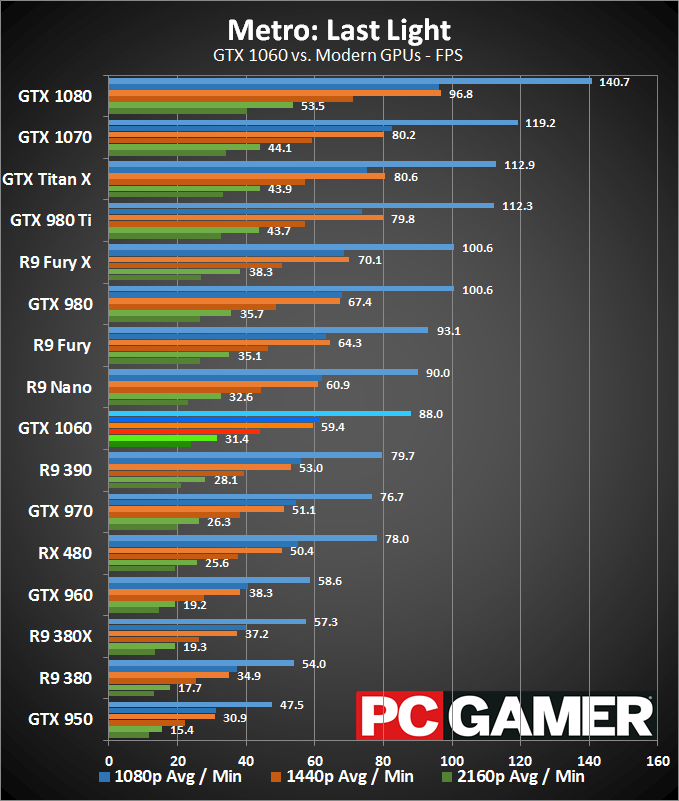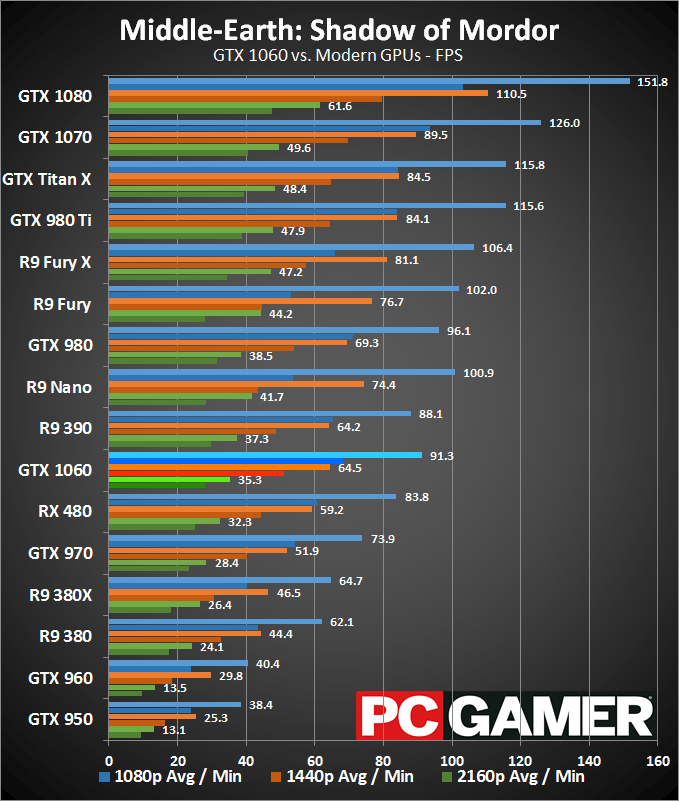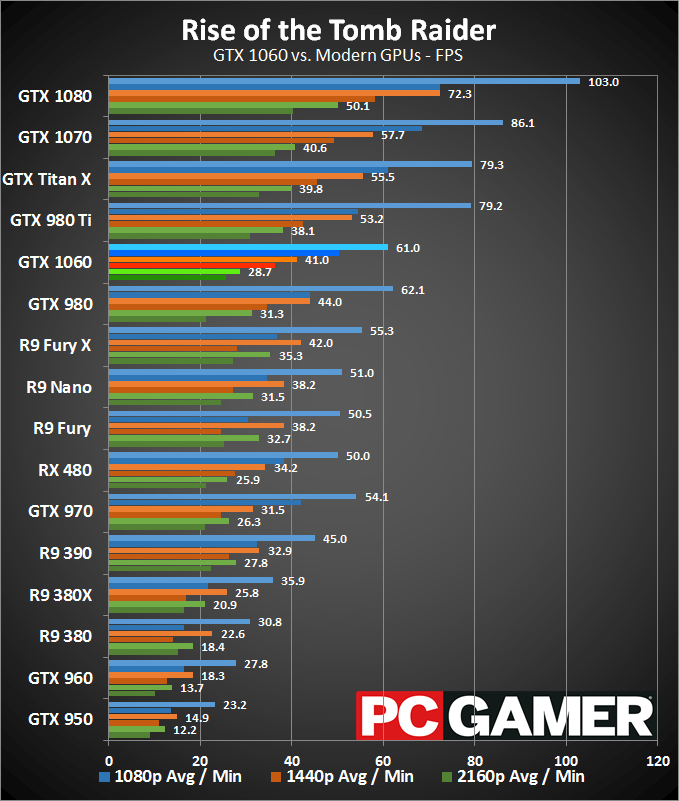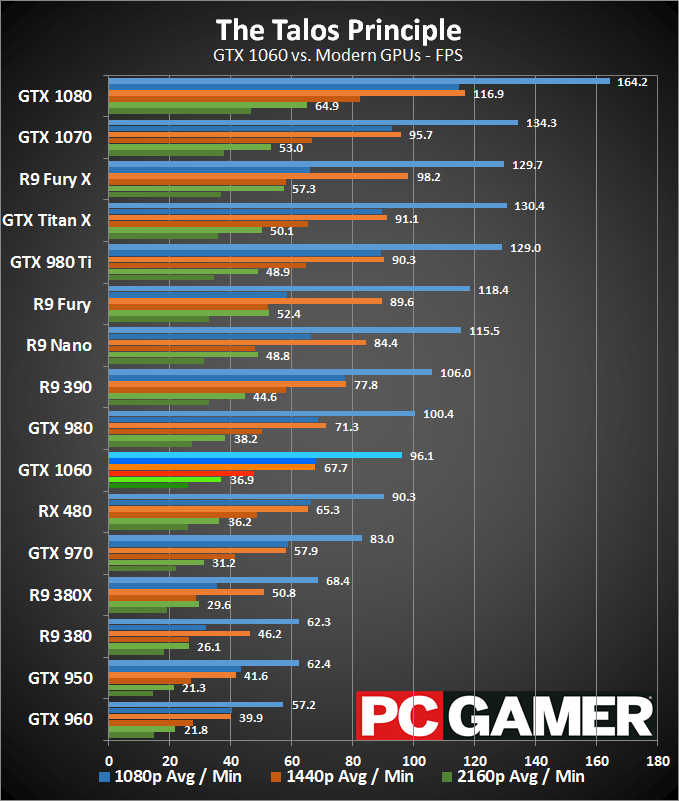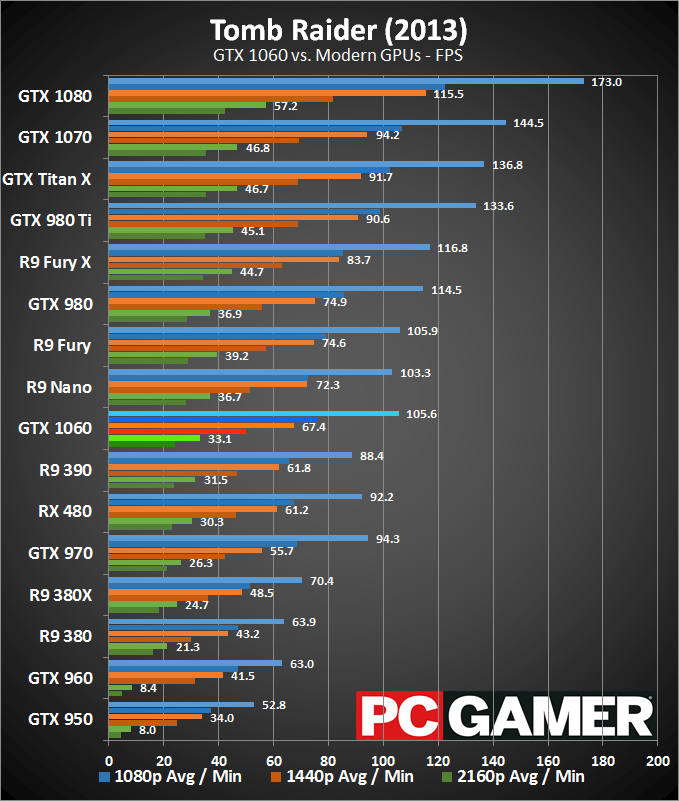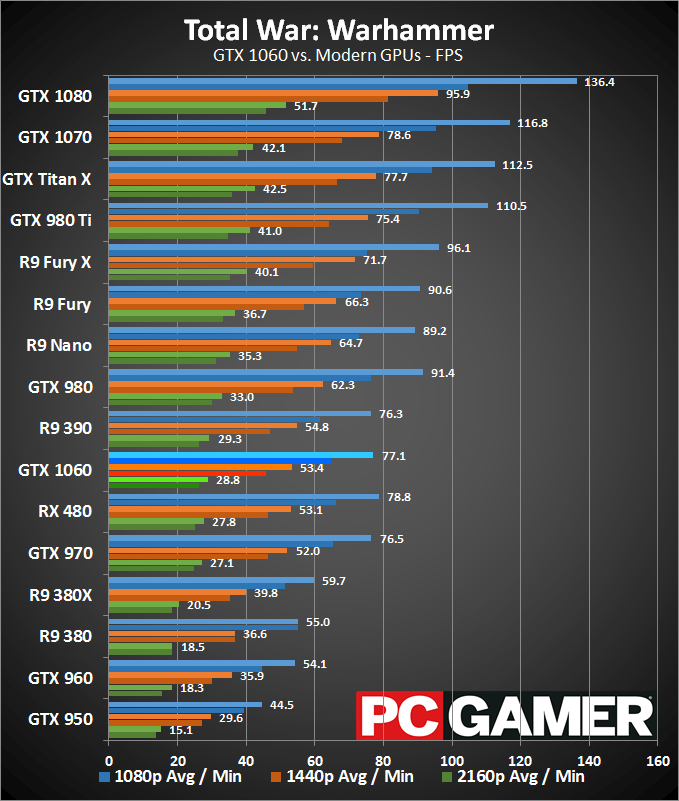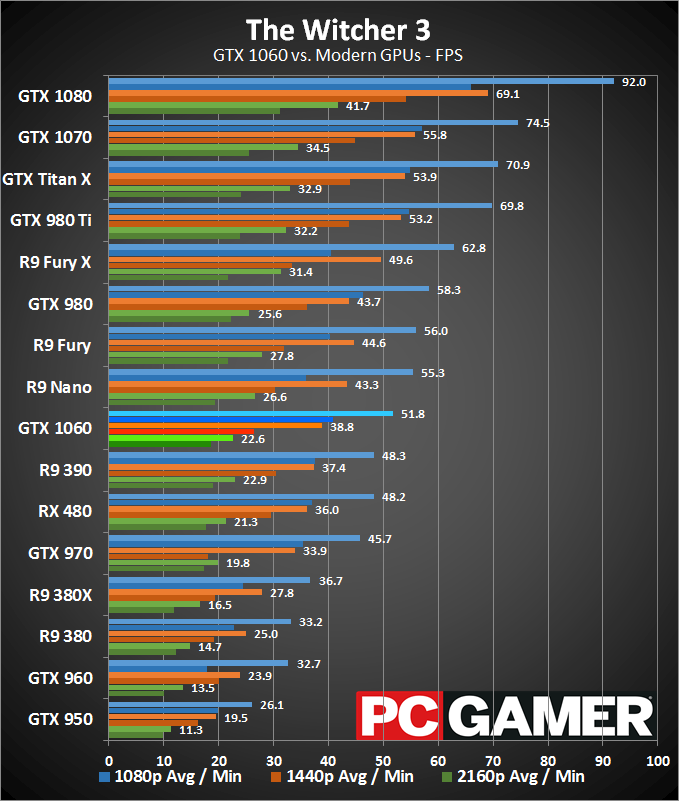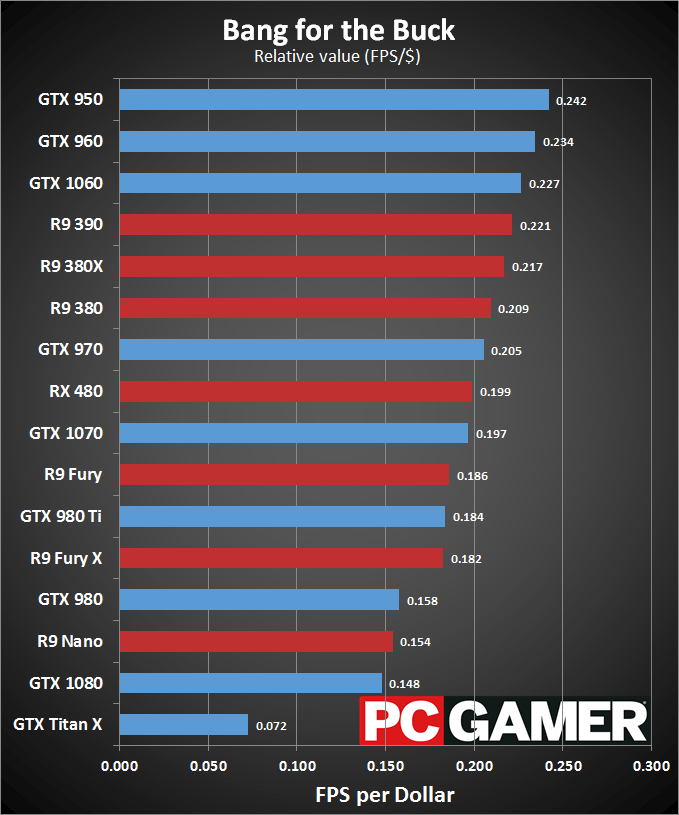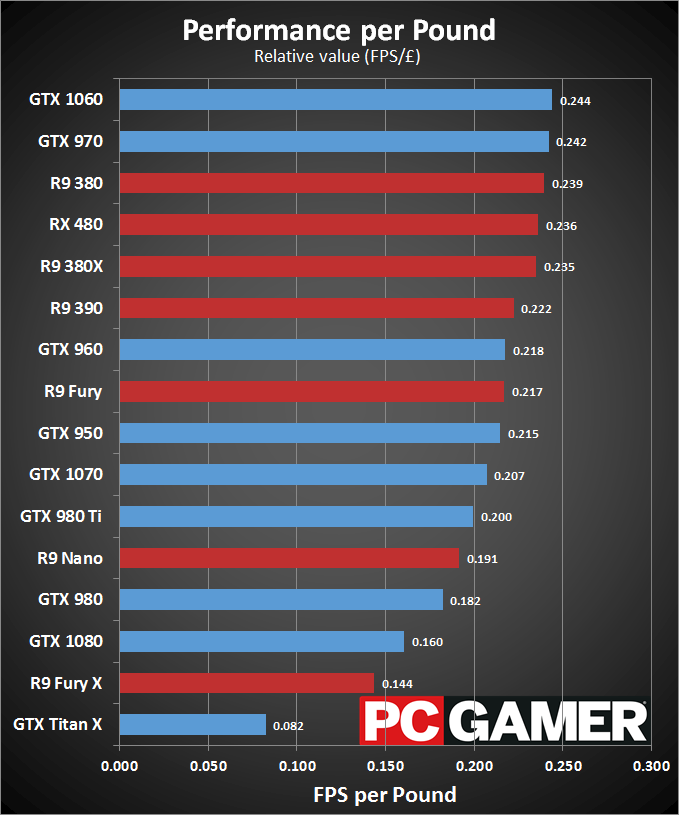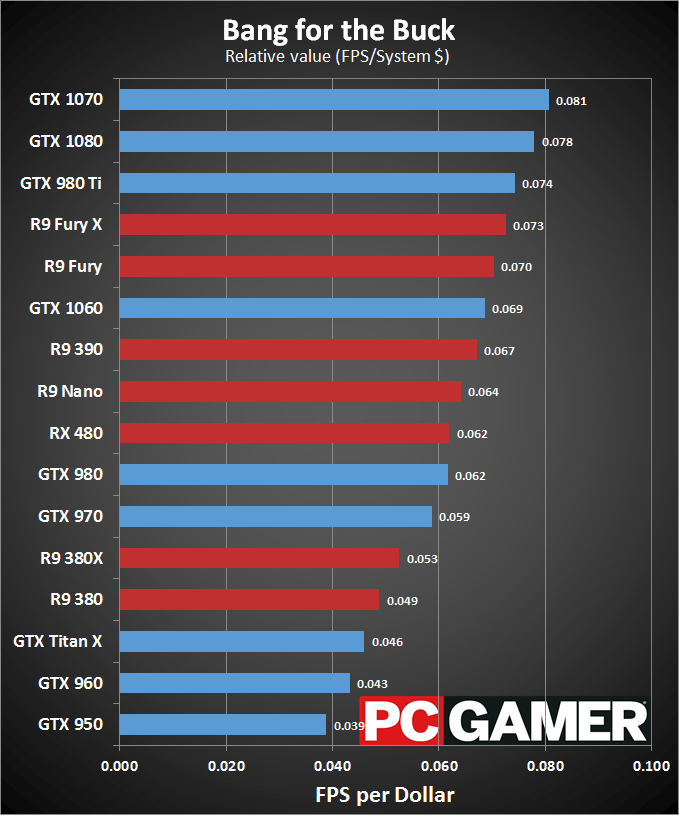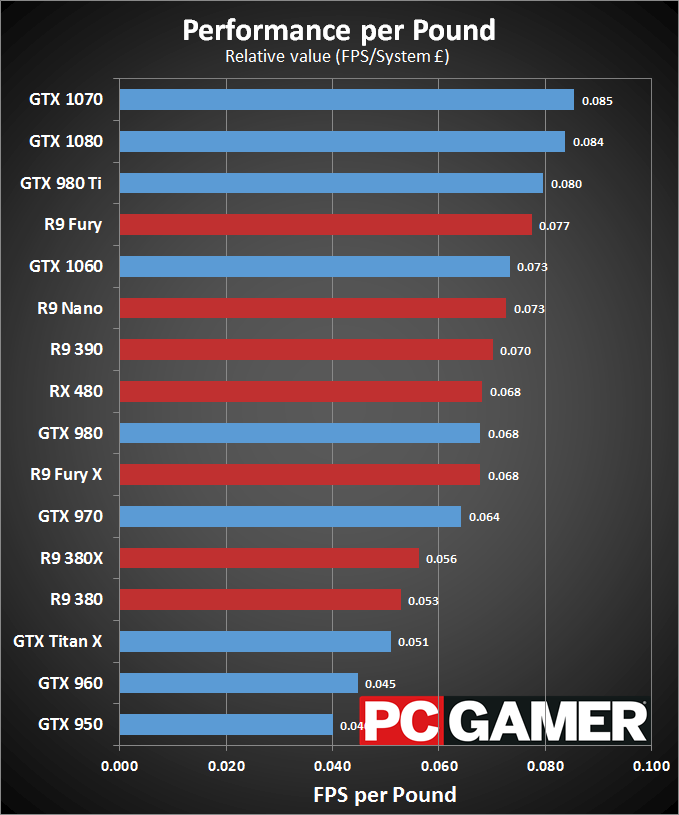Our Verdict
The Nvidia GTX 1060 is an excellent 1080p card that won't break the bank. It falls short of the power and performance of higher-end GPUs but for those on a budget it's an ideal choice
For
- Excellent value
- Great 1080p card
- Superb gaming laptop GPU
Against
- Not suitable for 4K
PC Gamer's got your back
First off, apologies for the delay in getting this full review posted. Simply put, life happens. The good news is that the delay has allowed things to settle down a bit in the graphics card market, meaning there are actually GTX 1060 cards available. The rest of the market is also filling out, with inventory on most of the new GPUs in stock on a regular basis. Prices are still a bit higher than we'd like in most cases, but it's no longer impossible to buy Pascal or Polaris. One month after the official launch and our preview of the 1060, things are looking much better and we can actually make some meaningful price/performance comparisons.
Let's start with online pricing, since that's often the most pressing issue for buyers. There are actually a few cards occasionally showing up at the bottom of Nvidia's suggested $250-$300 price range, with other non-Founders Edition cards priced below $300. GTX 1070 and GTX 1080 are also in stock, and like the 1060 they're also available below Founders Edition prices.
Meanwhile, AMD has launched its RX 480, RX 470, and RX 460, all going after market share with suggested prices below that of the GTX 1060; RX 480 remains overpriced right now, unfortunately. I haven't had a chance to test the RX 470 and RX 460 yet (see 'life happens' above), but performance figures elsewhere have the RX 470 trailing the RX 480 by about 15 percent; the RX 460 meanwhile is a distinctly budget GPU, sitting about 40 percent below the RX 470 and less than half the performance of the RX 480…but also half the price. I'll be putting together full reviews and performance numbers over the next week or so, but today let's talk about the GTX 1060—which is one of the best graphics cards you can buy.
The GeForce GTX 1060 is currently the lowest tier Pascal GPU from Nvidia, occupying the $250-$300 price range. (There's bound to be a GTX 1050 at some point, of course, but officially that doesn't quite exist just yet.) Performance is supposed to be on par with the GTX 980, a card formerly priced around $500, though as we'll see below, in many cases the 980 still wins. Looking to the future, however, upcoming games may leverage some of the hardware features baked into Pascal to extract more performance. We saw this happen with the Maxwell GTX 900 series over time, where initial parity with the existing Kepler GTX 700 series cards eventually ended up being a relatively large performance advantage for Maxwell.
Much like the other Pascal GPUs, GTX 1060 is able to increase clock speeds relative to the previous generation by a healthy margin—30 to 45 percent compared to the GTX 960, to be precise. Combined with 25 percent more CUDA cores and 15 percent higher memory clocks, along with a 50 percent wider memory bus, the resulting performance is at times more than twice as fast. Perhaps more impressively, all of this extra performance comes without increasing the power requirements, so a single 6-pin PEG connector is sufficient (though some custom overclocked cards will include an 8-pin connector).
But since we just finished talking about prices, much like the RX 480 we have to temper our enthusiasm slightly. The GTX 1060 is a worthy successor to the GTX 960, but pricing has increased by at least $50, if not $100, which means in some ways it's really more of a replacement for the GTX 970. And if you're currently running a GTX 970, the performance increase isn't really that large right now.
New features like simultaneous multi-projection make this the better card, and if you're upgrading graphics cards then you're more likely looking at replacing something from the GTX 700 era, if not a GTX 600/500 series card (or an AMD equivalent like the R9 280/HD 7950). At $250 this is a nice card, but budget-minded gamers are more likely to be swayed by the sub-$200 prices on RX 470—or wait and see what the GTX 1050 has to offer at some point in the future.
Keep up to date with the most important stories and the best deals, as picked by the PC Gamer team.
One final tidbit that might sway buyers into opting for the more expensive GTX 1070/1080 is that Nvidia doesn't support SLI on the GTX 1060. This might seem like a major problem, but in practice most users I've encountered typically don't do SLI (or CF) unless they're already using a high-end graphics card. Still, it does give AMD's RX 480 a potential advantage for dual-GPU systems.
The lack of SLI support also goes along with Nvidia's message on the GTX 1080/1070, where they specifically recommend against going beyond two GPUs at this point. It's still possible to do so—and you could always add a third GPU for PhysX, though there aren't really enough PhysX enabled games around to make that a compelling argument—but going forward it looks like dual-GPUs is now the recommended 'maximum' configuration. Of course game developers are free to use low-level APIs (DX12 and Vulkan) and features like explicit multi-adapter to take advantage of multiple GPUs—Ashes of the Singularity does this—but so far developers haven't been eager to do so.
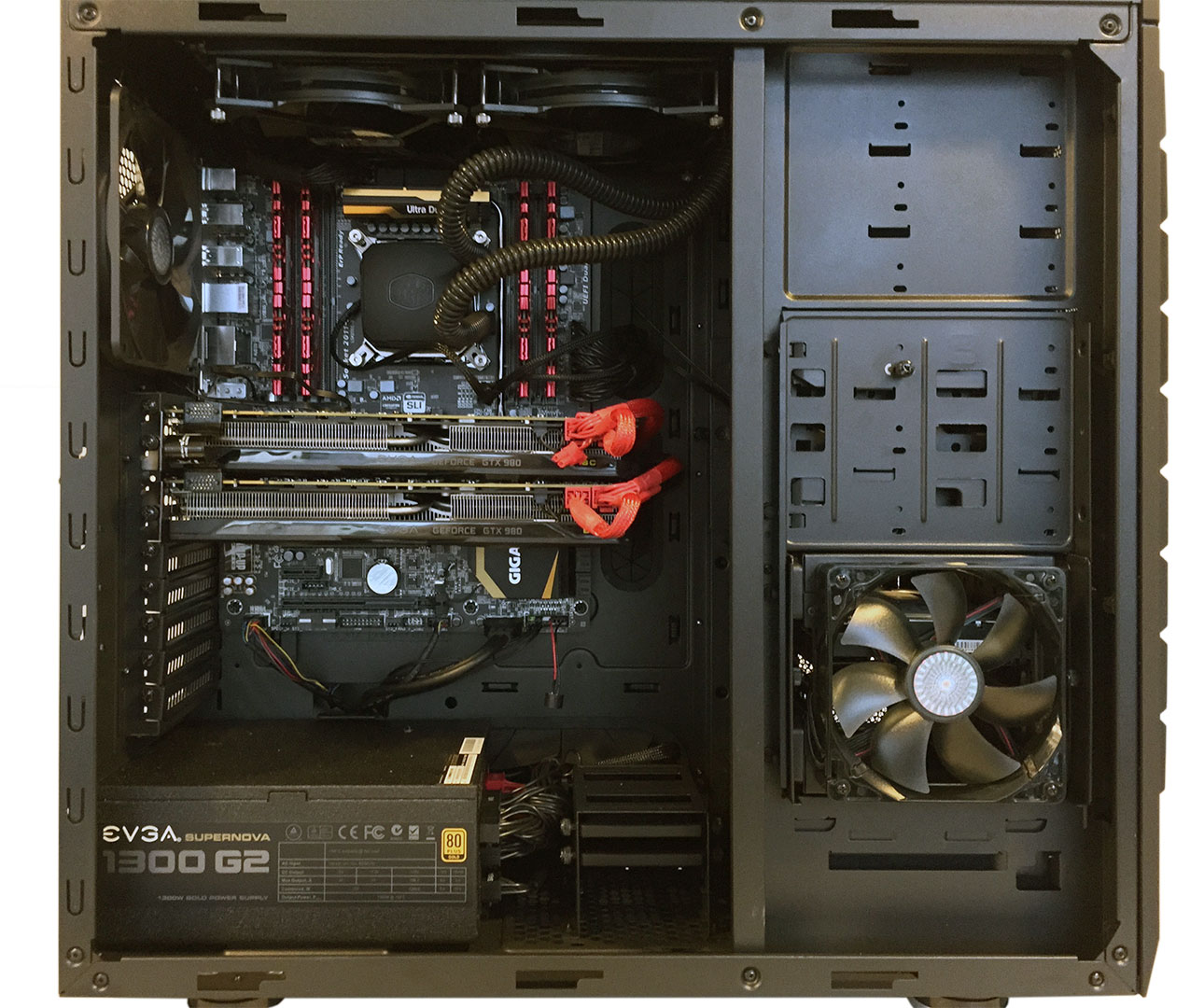
CPU: Intel Core i7-5930K @ 4.2GHz
Mobo: Gigabyte GA-X99-UD4
RAM: G.Skill Ripjaws 16GB DDR4-2666
Storage: Samsung 850 EVO 2TB
PSU: EVGA SuperNOVA 1300 G2
CPU cooler: Cooler Master Nepton 280L
Case: Cooler Master CM Storm Trooper
OS: Windows 10 Pro 64-bit
Drivers: AMD Crimson 16.7.1, Nvidia 372.54
GTX 1060 performance
So how does GTX 1060 perform? In between our initial preview and this final review, we've had a few changes in our benchmarks. Specifically, I was able to test Doom using the Vulkan API, which proved a real boon to AMD GPUs (but only helped a few select Nvidia cards, mostly where CPU bottlenecks were present—like on the GTX 1080). Other than that change and a few updates to other scores, the preview results remain mostly the same.
Our test bed continues to be a Core i7-5930K @ 4.2GHz, which I've been using for over a year, and frankly it shows no signs of needing an update. I've tested the latest processors from Intel and AMD, and while a few may add a couple of frames per second in certain cases, changing the test bed isn't something to be done lightly. Most games remain predominantly GPU bottlenecked, with the only exception being the fastest cards running at 1080p; maybe by the time we see Kaby Lake or Zen it will be time for an overhaul.
Here are the full benchmark results:
Starting with the high-level overview, looking at average performance across sixteen games, the GTX 1060 ends up coming in just shy of the GTX 980 and slightly ahead of the R9 390. It also beats AMD's RX 480 by a moderate 10 percent, or the GTX 970 by 20 percent. At the bottom of our charts, it's also twice as fast as the GTX 950; that card is roughly on par with a GTX 760 or GTX 670 if you're wondering about older hardware. For older AMD cards, the GTX 960 is a pretty close match for the HD 7970 and R9 280, and the GTX 1060 is about 80 percent faster than those. This is basically the same story as AMD's RX 480: More performance at a lower price with reduced power requirements, but the performance isn't going to set any new records.
Ashes tested using the Extreme preset.
In terms of frame rates, Ashes (at our selected settings) is the most demanding game in our test suite, with only three cards breaking the 60 fps mark at 1080p. Somewhat surprisingly, even in an AMD-centric title that includes DX12 support, the GTX 1060 comes out ahead of both the R9 390 and RX 480. This is also one of its better showings relative to the GTX 980, leading by up to 12 percent at 1440p. As the oldest DX12 title in our suite, it's possible Nvidia (or developers Oxide) have found ways to improve Nvidia's DX12 performance, or maybe the new hardware features of Pascal just lend themselves well to Ashes of the Singularity.
Batman tested at maximum quality with 4xMSAA, without PhysX.
The 1060 has a good showing in Arkham Origins, but it's also one of the oldest games in our test suite. Why no Arkham Knight? Oh, that's right: The PC port was a buggy mess that never got fully fixed (IMO). So I've stuck with the prior release.
Division 1080p/1440p tested using Ultra preset; 4K used the High preset.
The Division is a demanding game, with the 1060 and 480 both failing to break 60 fps at 1080p—dropping down to the 'High' preset would help, but it's still surprising to see new $250+ hardware failing to deliver 60 fps at ultra quality. If the results in Ashes were surprising, The Division is basically the reverse of those. Here, the RX 480 ties the 1060 (just barely ahead by our overall weighting of results), and this is an Nvidia game. This is also one of the best showings for the RX 480 relative to the R9 390, where the improved geometry engine in Polaris appears to help quite a bit.
Doom tested at Ultra with SMAA, using Vulkan API.
The Vulkan API has turned our Doom results on their head. Previously, Nvidia dominated in this title, but only the GTX 1080 and 1070 really see much benefit from Vulkan; all of the other Nvidia cards are basically the same performance as OpenGL. Contrast that with AMD's results, where every single card we tested sees healthy 15-30 percent gains in performance. Along with Hitman, this is one of two games where the RX 480 has a clear lead over the GTX 1060.
Fallout 4 tested using the Ultra preset.
Fallout uses a few Nvidia technologies, and it also tends to favor Nvidia GPUs at 1080p by a larger margin. Given the target audience for the 1060, the 4K results aren't particularly important, and overall the newcomer does quite well.
Far Cry tested using the Ultra preset with the HD texture pack.
Far Cry Primal is another taxing game, with many high-end cards failing to break 60 fps even at lower resolutions. The 1060 gets there, along with the R9 390, but the RX 480 comes up just short. Dropping a few sliders a notch or running at 1440p High is recommended for most of the GPUs.
GTAV 1080p/1440p used maximum quality (High/Very High/Ultra) settings with 4xMSAA, on the reflections as well. For 4K, MSAA is off (also off on reflections) and FXAA is enabled. The Advanced Graphics settings are all 'off.'
GTAV holds the dubious distinction of having the most knobs and sliders to fiddle with when it comes to graphics quality. It's also a game that tends to favor Nvidia hardware by a fairly wide margin, and it's the best showing for the 1060 relative to the RX 480, with Nvidia leading by 30 percent or more at 1080p/1440p.
Hitman (2016) tested using DX12 mode with SMAA; 1080p/1440p used maximum (High/Ultra) settings while 4K used High.
Along with Doom (Vulkan), Hitman (DX12) is the only other game tested where the RX 480 clearly bests the GTX 1060. The game also sports an AMD Gaming Evolved logo, so perhaps the companies aren't on equal footing here, but there are indications that DX12 enabled games may follow this pattern. RX 480 beats the 1060 by just over 10 percent here, so it's by no means a landslide victory, and with 480 prices still higher than expected it's more of a wash right now. Long term, we'll have to see what happens.
Hitman: Absolution tested using Ultra preset with 4xMSAA.
Going back to another old game, Absolution basically returns us to the status quo. The 1060 and other Pascal cards also seem to benefit a lot from their improved delta color compression, with minimum fps typically much higher than the other cards.
Metro testing with all settings at max but without SSAA or Advanced PhysX.
Another older title, this time from the Nvidia camp, Last Light matches our overall rankings of GPUs in most cases, with a few Nvidia cards doing better than expected—e.g., the 970 bests the 480, and the 960 beats the 380X. This is why we don't read too much into any single result. The 980 also has its second largest lead over the 1060 in Metro, beating it by nearly 15 percent.
Mordor tested using the Ultra preset.
Shadow of Mordor is one of the few games in the test suite that really benefits from more VRAM, even at 1080p—the 2GB cards (960 and 950) can't really handle Ultra quality that well, though you can always drop the settings a bit to improve performance. The 1060 and R9 390 end up essentially tied, with the RX 480 slightly behind, again matching our overall scores quite well.
Rise tested using DX11 (for now); 1080p/1440p at Very High with MSAA; 4K at High with FXAA. (DX12 performance is currently worse on all cards I've checked.)
I admit to not having retested Rise of the Tomb Raider with DX12 in a few months, so things may have changed, but for now all of the results come from the DX11 version. (I'll see about checking some AMD cards in the near future.) Given this is an Nvidia title and uses several Nvidia technologies, it's not too surprising that this is one of the bigger gaps between the 1060 and 480, favoring the Nvidia card by around 20 percent. Even the Fury X is surpassed by the 1060, though again I need to see about retesting….
Talos tested using DX11 and Ultra settings with 'Unlimited' (native) rendering resolution and 4xMSAA. (Vulkan performance is currently worse on all cards I've checked.)
Much like Rise of the Tomb Raider, The Talos Principle doesn't currently benefit from running the Vulkan API vs. the DX11 API. Vulkan tends to perform better than the OpenGL path, but DX11 is faster than either one. This is also a game where the 390 does particularly well compared to the other cards, beating both the 980 and the 1060, which in turn beat the 480.
Tome Raider (2013) tested using the Ultimate preset.
The previous Tomb Raider game shows a bit of odd behavior at 1080p on some of the 'mainstream' GPUs (390, 480, 970, and 1060), likely due to the use of TressFX—the newer GPUs often have better geometry throughput. Otherwise there's not much new to discuss.
Warhammer tested using DX12 on AMD and DX11 on Nvidia, using the Ultra preset. In this game, DX12 improves AMD performance but reduces Nvidia performance, without changing the rendered output.
API questions aside, the current order of ranking in Warhammer is nearly the same as our overall average, the only exception being the 1060 and 390, which have swapped places. Those two cards along with the RX 480 and GTX 1070 are all within a hair's breadth of each other in this game, though, and outside of benchmarks you're not likely to notice the difference.
Witcher tested using Ultra preset with HairWorks turned off.
Last in the list, The Witcher 3 is another demanding game where many cards fail to break 60 fps at the chosen settings—and if you want to make it even more taxing, turning on HairWorks typically knocks another 15-20 percent off the frame rates. The 1060 again comes out ahead of its direct competition, which it should considering the suggested prices.
Overclocking potential
We're using the Founders Edition for this initial review, which likely won't be the best overclocking model for the GTX 1060. Still, we were able to use EVGA Precision X16 to bump the clocks up a fair amount, and boosted the voltage, power, and temperature targets. Along with maxing out the voltage and temp/power targets, we set the GPU core to +215MHz and the VRAM to +600MHz—nearly the same settings we used on the GTX 1070, but not quite as high.
Note that we also had to set the fan speed to 90 percent to keep things stable, which isn't really something we'd recommend for long-term use, though we'd expect some of the custom 1060 cards to handle such settings with relative ease. With these settings, we achieved around a 15 percent improvement for performance across our test suite.
The value proposition
There's no arguing with the fact that Nvidia's Pascal GPUs are currently the fastest graphics chips around. From the Titan X to the GTX 1080 to the 1070, Pascal reigns supreme. However, there's also no question about those three cards being some of the most expensive graphics solutions currently available. We've seen $700 GPUs before, but without serious competition at the high-end, Nvidia seems in no rush to reduce prices. What they are willing to do is offer a lower performance part at a better price, and that's what the GTX 1060 does.
I often look at the overall value of a graphics card in terms of bang-for-the-buck, or more specifically, how many frames per second you'll get on average per dollar (or pound/Euro/whatever) spent. Let's do that and see how the GTX 1060 fares.
How's that for a change? I've even been a bit nice to the RX 480 and listed a price of $260, even though in the US at least it's nearly impossible (still) to find the card on sale below $300. But if you look back at previous GPU reviews, you'll see that many of the older cards have become better values, thanks to reduced prices. The GTX 1060 effectively becomes the best value for the time being, because even though the GTX 960 and 950 are ahead of it (in the US), they're so much slower that I can't really recommend them any longer.
There's one big problem with the above 'value based' charts: They're only looking at the cost of the graphics card; what about people looking to build a new system? Once you factor in even a modest system price, it sways the ranking much more in favor of the higher-end GPUs. For the following, I've used a base system price of $575/£540 (Core i5-6600K, Z170 motherboard, 2x8GB DDR4, 480GB SSD, 500W 80 Plus Gold PSU, and a decent ATX case); watch what happens:
Factoring in the cost of the rest of the system radically changes the value proposition. Now, some of the most expensive GPUs end up at the top of the charts, while the budget offerings fall to the bottom—the GTX 950 and 960 even rank below the GTX Titan X!
But these two sets of charts both offer a rather narrow perspective on which GPUs are the best value, and the 'truth' of the matter—if there is such a thing—is going to be somewhere in the middle. If you're just getting into PC gaming and have a decent system that doesn't have a graphics card, the first charts will have more value, while anyone building a completely new system will want to pay more attention to the second set of charts—keeping in mind the overall budget in either case.
To buy or not to buy…
Should you buy a GTX 1060? That depends largely on what you're currently running and whether you're unhappy with the performance it offers. It also depends a great deal on how much you're willing to spend on a graphics card.
If you're using a card like the GTX 960 or slower, $250 for a GTX 1060 is a good deal. Certainly the 1060 is a better gaming option than the RX 480 right now, based on performance, availability, price, and power requirements. But if you have anything near the performance of a GTX 970, the need to upgrade becomes far less critical. The best graphics card in the world is still just one element of gaming, and many excellent games don't require much more than a moderate GPU.
If the question comes down to AMD's RX 480 or Nvidia's GTX 1060, at the suggested retail prices of $200/$240 for the 4GB/8GB RX 480 versus $250 for the GTX 1060, there are a few ways to look at things. For the games we've tested, overall the 1060 beats the 480 8GB by ten percent on average, with a theoretical (for now) price increase of four percent. Winner: GTX 1060. But for a lot of games, there's not a huge difference between RX 480 4GB and 8GB; 25 percent higher price for 10 percent more performance? Winner: RX 480 4GB (provided you can find it for $200). In either case, I'd suggest setting your sights on 1080p Ultra or 1440p High, or you're likely to end up with some stuttering.
And there's still the dual-GPU question; I typically advise going with a single faster GPU if possible, and only suggest SLI/CF once you're near the top (GTX 1070 or R9 Fury or above, basically), but if you're thinking you might want to add a second GPU down the road, GTX 1060 doesn't support SLI. Winner by a nose: RX 480.
Big Pascal's little brother
With the GTX 1060 now launched, Nvidia has successfully released most of its Pascal GPUs for desktops. We'll still probably see a GTX 1080 Ti as a slightly trimmed version of the Titan X at some point, and GTX 1050 will undoubtedly go after the sub-$200 market, but in either case we already know what to expect: More performance than the GTX 1080 (but less than Titan X) at a higher price, or less performance than a 1060 at a lower price.
Even more impressive to me is that Nvidia is essentially stuffing full-fat 10-series GPUs into notebooks this round, so if you're looking for a gaming notebook that can hang with the desktops, we're closer than ever to performance parity—just be prepared for a bit of sticker shock if you go mobile, though remember you do get an integrated display, keyboard, speakers, and touchpad.
We're also entering the 'quiet time' after a major GPU launch, which means Nvidia has now shown its hand and we're not likely to see any radical changes in its GPU lineup for quite some time—the next major architecture, Volta, isn't due out until 2018. If you're looking for a GPU that will last a few years, then, now is as good a time as ever to buy. The only wildcard that remains is AMD's Vega, slated for later this year or early 2017, which will likely go after the GTX 1080 or even the Titan X. (Spoiler alert: Nvidia will probably have the 1080 Ti launch just in time to compete with Vega, dropping prices on the GTX 1080/1070 as needed.)
The GTX 1060 isn't the fastest kid on the block, but he doesn't need to be. Instead, he's fast enough, smart enough, and perhaps most importantly, he won't break the bank. Those with deeper pockets can look to his older siblings with their rippling muscles and ooh and aah, but muscles aren't everything. Or at least, that's what I tell myself.
The Nvidia GTX 1060 is an excellent 1080p card that won't break the bank. It falls short of the power and performance of higher-end GPUs but for those on a budget it's an ideal choice
Jarred's love of computers dates back to the dark ages when his dad brought home a DOS 2.3 PC and he left his C-64 behind. He eventually built his first custom PC in 1990 with a 286 12MHz, only to discover it was already woefully outdated when Wing Commander was released a few months later. He holds a BS in Computer Science from Brigham Young University and has been working as a tech journalist since 2004, writing for AnandTech, Maximum PC, and PC Gamer. From the first S3 Virge '3D decelerators' to today's GPUs, Jarred keeps up with all the latest graphics trends and is the one to ask about game performance.
